Everything you need to know about Jamon Ibérico in 2024
Jamon Ibérico Guide
Overview of Jamón Ibérico
Jamón Ibérico is a special kind of ham that comes from Spain. It’s not just any ham – it’s made from a unique breed called Ibérico pigs. These pigs are known for their quality and taste.
The process of making Jamón Ibérico is quite interesting. First, the Ibérico pigs roam freely in the Spanish countryside, feasting on acorns, herbs, and other natural foods. This gives the ham its distinctive flavor.
After a period of natural grazing, the pigs undergo a careful curing process. The ham is seasoned with sea salt and left to air-dry for several weeks. This allows the flavors to develop and intensify.
One special thing about Jamón Ibérico is the marbling – the fat in the meat is distributed uniquely, making it tender and flavorful. The curing process can take anywhere from one to four years, depending on the type of Jamón Ibérico.
People enjoy Jamón Ibérico in various ways – thinly sliced, as it is, or paired with cheese and bread. It’s a delicious and traditional part of Spanish cuisine that has gained popularity worldwide.
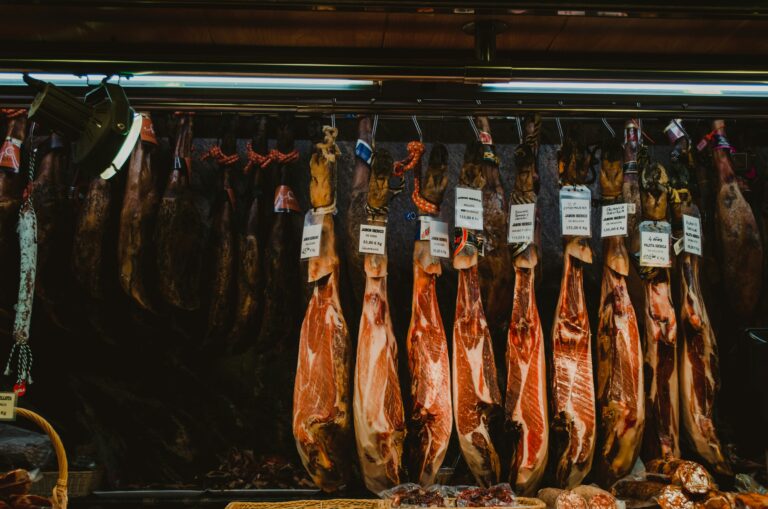
Importance of Jamón Ibérico in Spanish Cuisine
Jamón Ibérico holds a special place in Spanish cuisine, playing a crucial role in the country’s culinary heritage. This unique ham, derived from the Ibérico pig, is valued for its rich taste and tender texture.
In Spain, meals often revolve around a shared experience, and Jamón Ibérico is a centerpiece on many occasions. Whether it’s a family gathering, a celebration, or a casual get-together, this ham is a favorite choice to enhance the dining experience.
The importance of Jamón Ibérico extends beyond its delectable taste. It represents a connection to tradition and the Spanish way of life. The meticulous process of raising Ibérico pigs, allowing them to graze freely on natural foods, and the careful curing process contribute to the cultural significance of this culinary delight.
Furthermore, the versatility of Jamón Ibérico makes it a staple in various dishes. Whether served on its own, thinly sliced, or incorporated into tapas, salads, or even sandwiches, its distinct flavor elevates the overall gastronomic experience.
The Origin and History of Jamón Ibérico
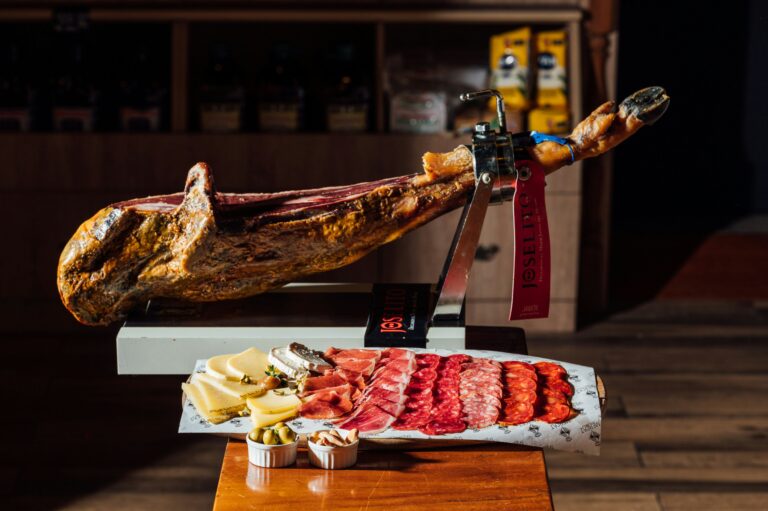
The story of Jamón Ibérico begins in Spain, where it has become a cherished part of the country’s culinary tradition. The origins trace back to the Ibérico pig, a unique breed known for its flavorful meat.
Centuries ago, the Ibérico pig was discovered in the Iberian Peninsula, which encompasses Spain and Portugal. These pigs roamed freely in the Spanish countryside, feasting on a natural diet of acorns, herbs, and grass. This diet contributes to the distinct taste that sets Jamón Ibérico apart.
Over time, the art of making Jamón Ibérico evolved. Spanish farmers learned to preserve and enhance the flavors by curing the ham with sea salt and allowing it to air-dry. This process not only added depth to the taste but also extended the shelf life of the ham.
The popularity of Jamón Ibérico grew, becoming a staple in Spanish households and an essential part of various celebrations. Its unique flavor and the careful craftsmanship involved in its production elevated it to a symbol of quality and tradition in Spanish cuisine.
Types and Grades of Jamón Ibérico
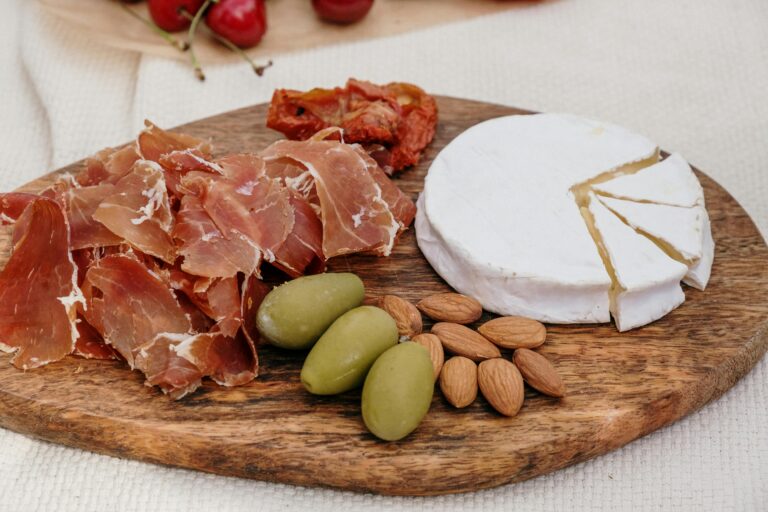
Jamón Ibérico comes in different types and grades, each offering a unique taste and quality. The two primary types are Jamón Ibérico de Bellota and Jamón Ibérico de Cebo.
Jamón Ibérico de Bellota is considered the highest quality. It comes from Ibérico pigs that freely roam and feed on acorns (bellotas) during a specific period. This type of ham is known for its marbling, resulting in tender and flavorful meat.
On the other hand, Jamón Ibérico de Cebo comes from Ibérico pigs that are also free-range but are primarily fed a diet of grains and legumes, without the acorn-rich diet. While still delicious, it tends to have a slightly leaner texture compared to the de Bellota variety.
Within these types, there are different grades based on the pig’s breeding conditions and diet. The highest grade is “Pata Negra,” indicating purebred Ibérico pigs. The next grade is “Ibérico,” where the pig is at least 50% Ibérico breed. Lastly, there’s the “Crossbreed” category, which includes pigs with less than 50% Ibérico heritage.
The Iberian Pig: Key to Jamón Ibérico Quality
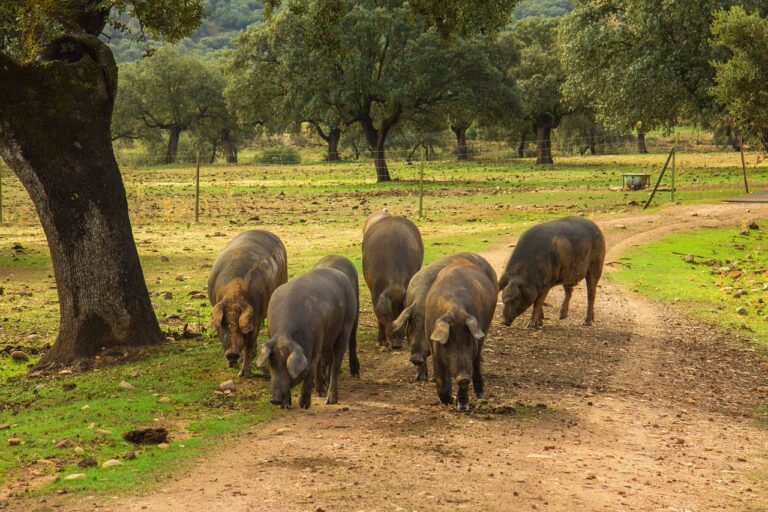
The Iberian pig is the secret behind the exceptional quality of Jamón Ibérico. This special breed, native to the Iberian Peninsula, plays a crucial role in shaping the unique and delicious flavor of the ham.
These pigs are known for their distinctive features – a dark coat, long snout, and slender legs. They are well-suited to the Spanish countryside, where they roam freely, enjoying a diet of acorns, herbs, and grass. It’s this natural and varied diet that imparts a special taste to the meat.
The Iberian pig’s lifestyle contributes to the marbling of the meat, where fat is distributed throughout the muscle. This marbling not only enhances the flavor but also gives the ham its tender and melt-in-the-mouth texture.
Farmers take great care in raising Iberian pigs for Jamón Ibérico, ensuring they have enough space to graze and follow a natural diet. The happy and healthy life of these pigs contributes directly to the quality of the ham they produce.
Production Regions and Designations of Origin

Jamón Ibérico is not only about the pigs; it’s also about the regions where it’s produced. Different areas in Spain have their unique way of crafting this delicious ham.
These regions, known for their specific climates and traditions, contribute to the distinct characteristics of Jamón Ibérico. For instance, the climate in areas like Guijuelo, Jabugo, and Extremadura affects the curing process, adding nuances to the final flavor.
To ensure the authenticity and quality of Jamón Ibérico, some regions have received the designation of origin. This means that only hams produced in those specific areas can carry the prestigious label. It’s like a stamp of approval, ensuring you get the real deal.
The regions with designations of origin, such as Jamón de Huelva or Jamón de Guijuelo, adhere to strict standards. These standards cover everything from the pig’s diet to the curing process, guaranteeing a consistent and high-quality product.
Factors Affecting Quality
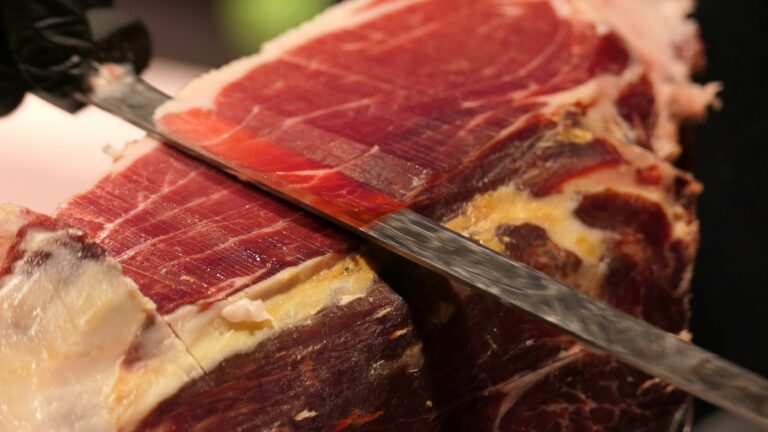
Several factors contribute to the quality of Jamón Ibérico, making it a delicious and sought-after delicacy. One key factor is the pig’s breed, specifically the Iberian pig. These pigs, with their distinct features and lifestyle, greatly influence the flavor and texture of the ham.
The pig’s diet is another crucial element. Those who graze freely on acorns and natural vegetation develop a unique taste compared to those on a grain-based diet. The natural flavors imparted by the pig’s diet contribute to the overall quality of the Jamón Ibérico.
The curing process is equally important. How long the ham is air-dried and seasoned with sea salt significantly affects its taste and texture. The meticulous craftsmanship during this phase, along with the climate of the production region, plays a vital role in creating the perfect balance of flavors.
Additionally, the region of production and any designation of origin further ensure the authenticity and quality of the Jamón Ibérico. Different regions have unique climates and traditions, influencing the final product.
Reading Jamón Ibérico Labels
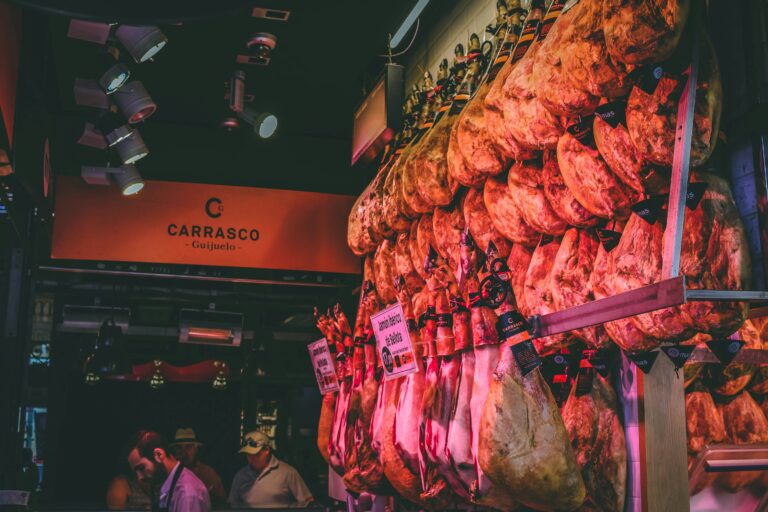
Understanding Jamón Ibérico labels can be quite simple once you know what to look for. When you pick up a pack of Jamón Ibérico, take a moment to read the label to ensure you’re getting the quality and type you desire.
Start by checking the type of Jamón Ibérico. There are two main types: Jamón Ibérico de Bellota and Jamón Ibérico de Cebo. De Bellota comes from pigs that feast on acorns, resulting in a richer flavor, while de Cebo comes from pigs with a grain-based diet, offering a slightly cleaner taste.
Next, look for the grade. “Pata Negra” indicates purebred Ibérico pigs, “Ibérico” means at least 50% Ibérico breed, and “Crossbreed” signifies less than 50% Ibérico heritage. This information tells you about the pig’s lineage, influencing the ham’s characteristics.
Keep an eye out for the designation of origin. This ensures the ham comes from a specific region with its unique traditions and flavors. Some well-known regions include Guijuelo, Jabugo, and Extremadura.
Where to Buy Authentic Jamón Ibérico

Finding authentic Jamón Ibérico can be a delightful experience when you know where to look. One reliable option is to explore local specialty stores or gourmet markets that focus on high-quality products. These establishments often carry authentic and carefully sourced Jamón Ibérico, ensuring you get the real deal.
If you prefer the convenience of online shopping, reputable websites that specialize in Spanish and gourmet foods can be a good choice. Look for customer reviews and ratings to ensure the authenticity and quality of the product. Many online platforms collaborate with trusted producers to deliver genuine Jamón Ibérico to your doorstep.
Consider visiting local Spanish or Mediterranean restaurants or delis. These establishments may offer Jamón Ibérico for purchase, and the staff is usually knowledgeable about the product, providing guidance based on your preferences.
Another option is seeking recommendations from friends or family who have experience with Jamón Ibérico. They may share insights on where to find authentic options, helping you make an informed decision.
Traditional Recipes Featuring Jamón Ibérico
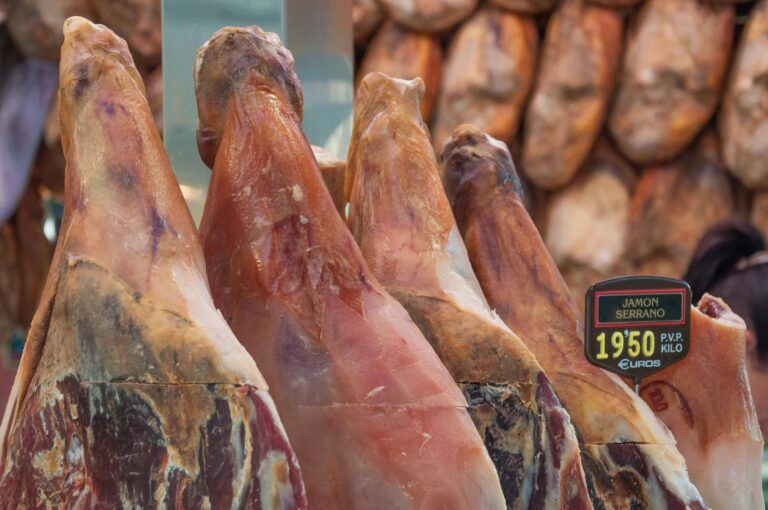
Jamón Ibérico adds a touch of excellence to various traditional recipes in Spanish cuisine. One classic dish is the “Bocadillo con Jamón,” a simple yet flavorful sandwich. Take a fresh baguette, spread a bit of tomato and olive oil, and layer slices of Jamón Ibérico for a delicious and quick snack.
Another favorite is “Huevos Rotos con Jamón,” translating to Broken Eggs with Ham. In this dish, fried eggs are served on a bed of crispy potatoes, topped with Jamón Ibérico. The runny yolk combines with the savory ham to create a delightful blend of flavors and textures.
For a heartier option, try “Paella de Mariscos con Jamón,” a seafood paella enriched with the smoky taste of Jamón Ibérico. The ham infuses the rice with its distinct flavor, complementing the array of seafood.
“Salmorejo con Jamón” is a refreshing cold soup perfect for warmer days. Blend tomatoes, bread, olive oil, and garlic, then top with finely chopped Jamón Ibérico for a tasty and cooling dish.
Lastly, don’t forget “Patatas Bravas con Jamón.” Crispy fried potatoes are drizzled with a spicy tomato sauce and adorned with generous slices of Jamón Ibérico, creating a tapas favorite that bursts with flavors.
Jamón Ibérico in Spanish Culture
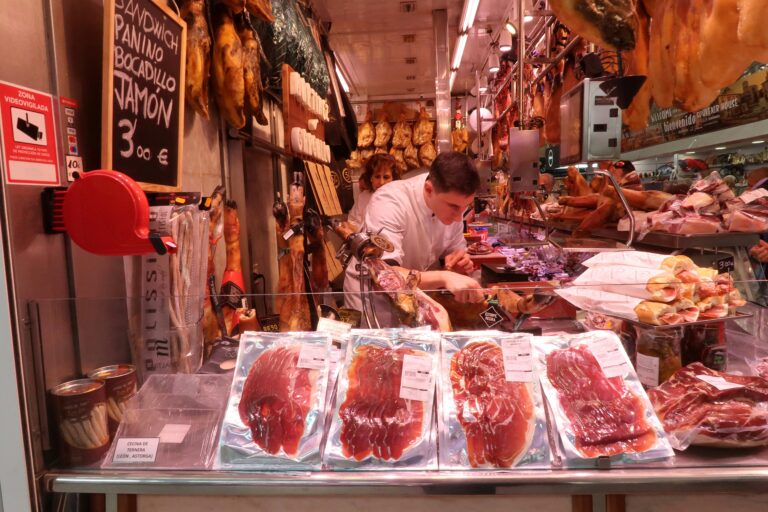
In Spanish culture, Jamón Ibérico holds a special place as more than just a food item – it’s a symbol of tradition and shared moments. Whether it’s a family gathering, a celebration, or a casual meal, Jamón Ibérico often takes center stage on the dining table.
The unique taste of Jamón Ibérico reflects the deep connection to the Spanish countryside. The free-roaming Iberian pigs, feasting on acorns and natural vegetation, contribute to the distinctive flavor of the ham. This connection to nature and the land is a cherished aspect of Spanish culture.
Jamón Ibérico is not just about eating; it’s about the experience of sharing. It’s common to see people gathered around a plate of thinly sliced ham, enjoying each bite with conversation and laughter. This communal aspect of sharing Jamón Ibérico is ingrained in Spanish social gatherings.
Moreover, this exceptional ham is not confined to special occasions; it’s a part of everyday life. From simple bocadillos (sandwiches) to more elaborate dishes, Jamón Ibérico finds its way into various meals, adding a touch of excellence to daily culinary experiences.
Festivals and Events Celebrating Jamón Ibérico
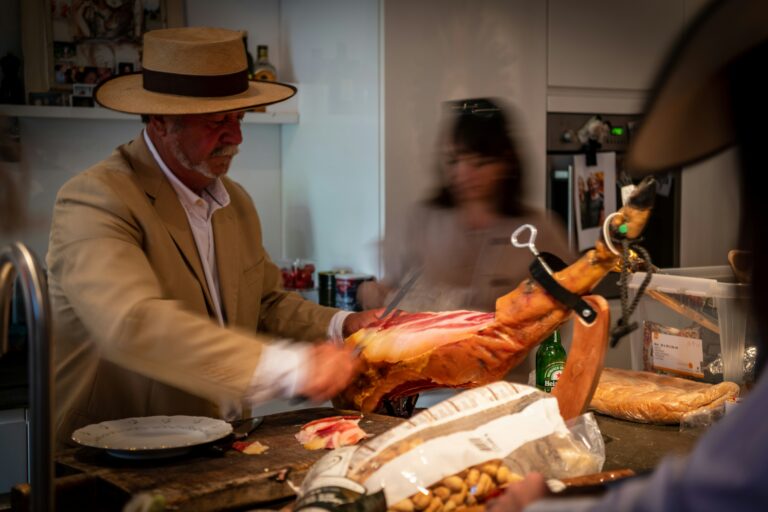
Celebrating Jamón Ibérico goes beyond the dining table, with festivals and events dedicated to this beloved Spanish delicacy. One such celebration is the “Feria del Jamón” or Ham Fair, where communities come together to showcase and enjoy the finest Jamón Ibérico.
During these festivals, you can experience the entire journey of Jamón Ibérico – from the grazing of the Iberian pigs to the meticulous curing process. It’s a chance to witness the craftsmanship involved and gain a deeper appreciation for the flavors that make this ham so special.
These events often feature competitions, where producers showcase their best Jamón Ibérico, competing for recognition and awards. Visitors have the opportunity to taste and compare different hams, discovering the nuances in flavor and texture.
Beyond the culinary aspects, Jamón Ibérico festivals embrace the cultural and social dimensions of the tradition. Live music, dance, and vibrant atmospheres create a festive ambiance, making these events a celebration of Spanish culture and community.
FAQs about Jamón Ibérico
What is the best Jamón Ibérico?
The best Jamón Ibérico is subjective and depends on personal taste. Some prefer the richness of Jamón Ibérico de Bellota, while others enjoy the slightly leaner Jamón Ibérico de Cebo.
What are the 4 categories of Iberian ham?
The four categories of Iberian ham are Pata Negra (purebred), Ibérico (at least 50% Iberian breed), Crossbreed (less than 50% Iberian breed), and Bellota (acorn-fed).
What are the 4 categories of Iberian ham?
To pick a good Jamón, look for specific details on the label, such as the type (Bellota or Cebo), grade (Pata Negra, Ibérico, or Crossbreed), and the region of origin. Check for marbling, which indicates a well-cured and flavorful ham.
What does 50% Iberico ham mean?
50% Iberico ham means the pig used for the ham is at least half the Iberian breed. The percentage influences the ham’s characteristics, with higher percentages generally associated with a more pronounced Iberian flavor.
